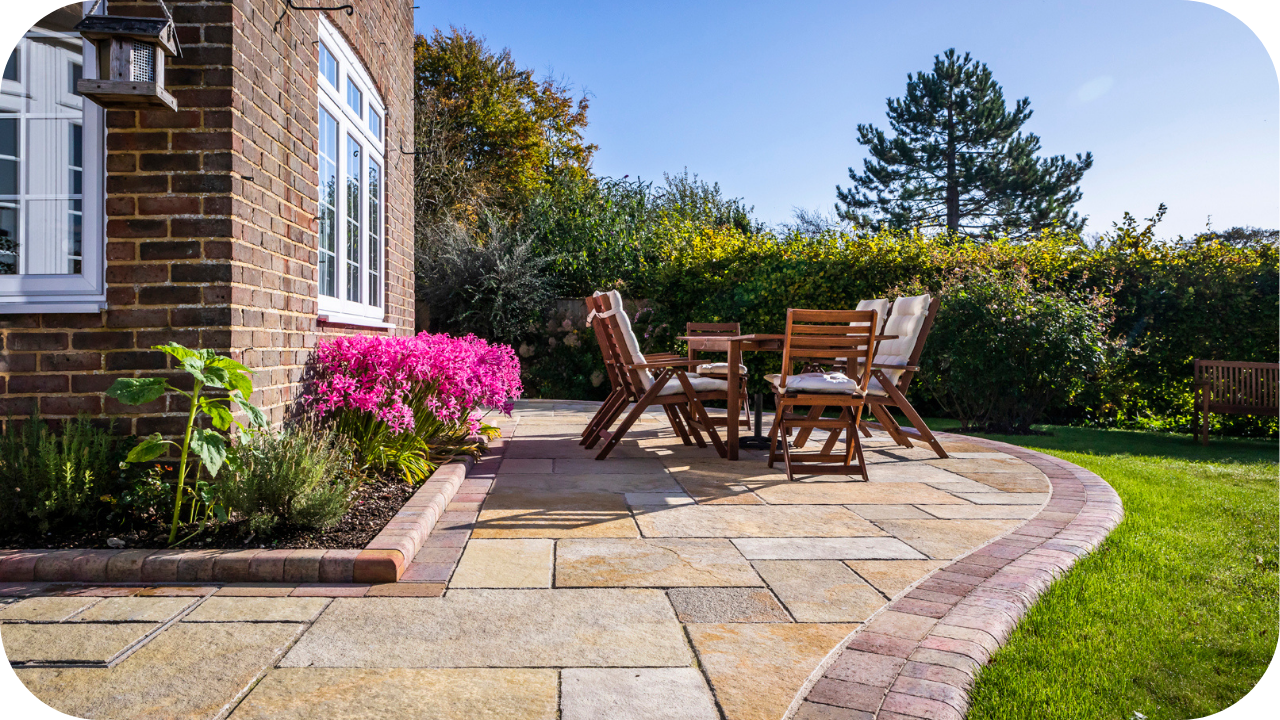
Well-designed landscapes rely on clean, defined edges to create structure and flow. Border paving stones provide a simple yet impactful way to frame outdoor elements while boosting durability and visual appeal.
Whether edging a garden bed, lining a pathway, or bordering a driveway, these stones help manage materials and deliver a high-end finish. Their practical benefits are matched by their design versatility.
This guide covers how to use border paving stones in different areas of your landscape, offering clear guidance on stone selection, layout, and long-term installation success.
Why Use Border Paving Stones in Landscaping?
Border paving stones serve both aesthetic and functional roles in landscaping, making them a smart addition to any outdoor project. They define transitions between different zones, helping to organise open spaces while guiding foot or vehicle traffic intuitively.
More than just decorative, they hold gravel, mulch, or soil in place, reducing mess and minimising the need for constant maintenance. Border stones also reinforce the edges of pavers and paths, preventing movement and erosion caused by weather or regular use.
When selected and laid correctly, they enhance the overall durability of your landscape design while lending a polished, professional finish. Their clean lines and contrast can elevate the visual flow of a garden, driveway, or entertaining space.
From rustic country styles to sleek urban looks, border paving stones offer a flexible, long-lasting solution for landscapers and homeowners looking to combine structure with beauty in outdoor spaces.
Best Areas to Use Border Paving Stones
Border stones are more than just finishing touches. They shape how outdoor spaces function, look, and last. Here’s where they make the biggest impact in your landscape design.
1. Pathways and Walkways
Border paving stones help define pedestrian paths, providing clear direction and a sense of order. They keep gravel or paving neatly contained while offering visual structure and added safety along curved or straight routes.
2. Driveways and Vehicle Zones
Edging stones reinforce the sides of driveways, preventing crumbling and surface spread. They’re especially useful for gravel or segmented driveways, offering added durability against tyres, weather exposure, and regular traffic pressure.
3. Garden Beds and Planters
Used around flower beds or planters, border pavers keep soil and mulch neatly in place. They also reduce unwanted plant overgrowth, helping to separate garden elements cleanly and making maintenance much easier.
4. Lawn Edges and Turf Boundaries
Paving borders around lawns helps maintain crisp grass edges while reducing trimming work. They also block grass from spreading into garden beds and give a sharp, polished look to open landscape designs.
5. Patio and Alfresco Zones
Edging stones give patios and alfresco areas a refined boundary. They protect adjoining surfaces from movement, frame the space elegantly, and allow for smooth transitions between paving and surrounding landscaping.
Choosing the Right Stone for Border Applications
To design a landscape that feels polished and lasts for years, choosing the right border stone is essential. Here are key considerations for a seamless result.
1. Think About Durability and Load
Choose stones that can withstand constant foot traffic, weather exposure, and occasional vehicle weight. Denser varieties like granite or bluestone are ideal for heavy-use borders, ensuring long-term performance without cracking, shifting, or degradation.
2. Prioritise Size and Profile
Select stone sizes that complement nearby surfaces. A wide, raised edge can create visual definition, while flush-set, low-profile stones deliver a subtle finish. The right dimensions ensure both form and function in your landscape.
3. Match Colour and Texture
Coordinating edging with your main paving or walling maintains visual continuity. Similar tones and textures create a seamless finish, helping the border blend effortlessly while still adding contrast or definition where needed.
4. Select Finishes for Safety and Style
Choose finishes that suit the intended space. Textured, tumbled surfaces add slip resistance and a softer appearance, while smooth finishes feel modern but require careful placement to avoid slips in wet areas.
5. Choose Locally Sourced Materials
Local stone reduces carbon footprint and supports regional quarries. It often suits the natural landscape better and may also offer shorter lead times, cost savings, and a more sustainable long-term building solution.
6. Factor in Maintenance Requirements
Choose stones that require minimal upkeep but still maintain their appearance over time. Opt for materials that naturally resist staining, moss growth, and weathering, reducing long-term cleaning and resealing needs in outdoor environments.
7. Consider the Overall Design Intent
Border stones should align with your landscape’s aesthetic. Whether you’re aiming for a clean, modern look or a rustic garden path, choose edging stones that support the mood, symmetry, and function of your design.
Design Ideas Using Border Paving Stones
To design an outdoor space that feels polished and well-considered, edging plays a vital role. These creative approaches help you balance structure, movement, and visual cohesion using natural stone borders.
1. Use contrasting stone tones to define edges
Select border stones in lighter or darker tones than the main surface to create strong visual definition. This adds clarity to paths, garden beds, and courtyards while enhancing layout structure and design flow.
2. Introduce curves to soften linear spaces
Curve border stone lines gently around garden beds or stepping paths to add a natural, flowing look. This breaks up harsh angles and encourages a more organic, welcoming feel across the landscape.
3. Frame stepping stone paths for structure
Install border stones along each side of a stepping stone trail to prevent gravel displacement. This technique also adds rhythm and order, guiding movement through the garden in a clean, controlled way.
4. Integrate edging with subtle lighting
Pair low-profile edging stones with in-ground lighting features to illuminate walkways, driveways, or seating areas. This ensures both safety and ambience without interfering with the natural appeal of the space.
5. Highlight planting zones with stone borders
Edge garden beds or planter boxes with stone to contain soil and mulch while adding crisp outlines. This keeps greenery looking neat and emphasises contrast between hard and soft landscaping materials.
6. Mix stone finishes for added texture
Combine smooth, flamed, or tumbled finishes in your edging stones to create subtle layers of texture. This visual depth helps elevate minimalist designs and keeps hardscaped areas feeling warm and dynamic.
Installation Tips for a Lasting Result
To make your border paving stones stand the test of time, proper installation is just as important as stone selection. Here are key tips for achieving long-lasting, secure results:
- Prepare a solid base: Excavate and level the area before laying any stone, ensuring a compacted base of crushed rock or road base to prevent sinking or shifting.
- Compact the foundation properly: Use a plate compactor to press down the base material thoroughly. A firm foundation improves stability and ensures the border remains intact over time.
- Lay stones using consistent spacing: Keep joints evenly spaced, whether you’re using mortar or dry-laying. Uniform gaps ensure a balanced look and help reduce the risk of movement.
- Choose flush or raised edging styles based on function: Flush borders blend seamlessly with pathways, while raised borders work better for controlling mulch or defining lawn edges.
- Use mortar for high-traffic zones: For driveways or paths with frequent footfall, securing the stones with mortar adds strength and prevents displacement under pressure.
- Account for drainage in your design: Slightly slope the border or incorporate gaps to encourage water runoff and prevent pooling that can weaken the installation.
- Check alignment with a string line: Use a taut string or guide to ensure each border stone stays straight, especially over long edges or curves.
- Finish with joint sand or mortar depending on style: Sweep in joint sand for dry-laid installs or point mortar joints for a clean, long-term bond in formal or high-use applications.
Conclusion
Border paving stones do more than define edges. They bring structure, style, and durability to your entire landscape. With the right stone and expert installation, your outdoor spaces will look polished and last for years.
For premium-quality border stones and tailored advice, speak to the team at Splendour in Stone and elevate your landscaping with confidence.
More To Explore

Grey Granite Cobblestones for Driveways: Strength and Style
Grey granite cobblestones combine strength, safety, and timeless appeal, making them a popular choice for Melbourne driveways and outdoor spaces. Their natural flamed texture offers

Granite Wall Cladding Melbourne: Modern and Classic Appeal
Granite wall cladding brings both modern sophistication and classic charm to Melbourne architecture. Known for its durability and natural beauty, granite transforms façades, feature walls,


